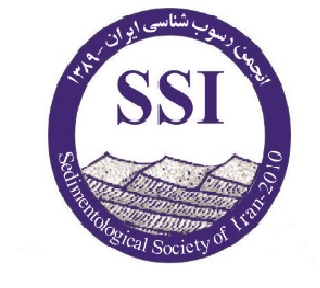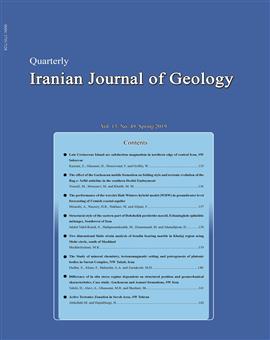Difference of in situ stress regime dependent on Structural position and geomechanical characteristics, Case study- Gachsaran and Asmari formations, SW Iran
Subject Areas :Hossein Talebi 1 , Seyd Ahmad Alavi 2 , Mohamad Reaz Ghasemi 3 , Shahram Sherkati 4
1 -
2 -
3 -
4 -
Abstract :
Estimation of in-situ stress tensor in sedimentary basins using information obtained from exploration and development oil and gas wells during the drilling and logging process may be used for estimation of in-situ stress tensor in sedimentary basins. The in-situ stress magnitude and orientation and the resulting stress regime around the studied wells have been several application in secondary recovery programs from hydrocarbon reservoirs as well as wellbore stability analysis. In this paper, the magnitude of in-situ stress is estimated by using abovementioned data in some oil wells located in the south west of Iran. Increasing the oil production by hydraulic fracturing design and sand control in the multi-layer reservoirs such as the Marun giant oil field with loose sand horizons and also improving drilling performance in the Gachsaran formation¬ requires knowledge about the prevailing stress conditions. This research, tries to analyze the stress regime of the Asmari and Gachsaran Formations around the selected wells in the Marun and Lali fields using constructed Mechanical Earth Models (MEM) and their differences are discussed. The calculated stress magnitudes in studied wells indicate a significant drop in magnitude of horizontal stresses from the Gachsaran to Asmari reservoirs in the Marun oil field. The magnitudes of the three principal stresses resulted that SHmax is the maximum principal stress and the Shmin is the minimum principal stress, thus a strike-slip stress regime (SHmax>Sv>Shmin) dominates in the Gachsaran sequence and the Asmari formation of the Lali oil field. however, in the Gachsaran formation of Marun giant oil field, stress regime is reverse-strike slip but normal stress regime is dominated in it's Asmari reservoir. The In-situ stress condition indicates that the structural condition and the depth difference of these structures plays an important role in the tectonic stress regime changes.
طالبي، ح. و نريماني، ح.، 1388. ارتباط ساختاري تاقديس هاي زيلويي، لالي و كارون. گزارش فني شركت ملي مناطق نفت خيز جنوب.
طالبي، ح.، علوي، ا.، قاسمي، م.ر.، پرهيزگار، م.ر. و بقاء دشتكي، ب.، 1392. راستا و بزرگاي تنش برجا در سازند آسماري حوضه زاگرس- فروبار دزفول شمالي. اولين همايش ملي زمين ساخت ايران.
فارسي مدان، م.، مهدور، م. و محمديان، ر.، 1392. بررسي عملكرد و تعيين جهت تنش برجا در سازند مخزني آسماري ميدان نفتي مارون (بر اساس نتايج تفسير نمودارهاي تصويرگر). سي و دومين گردهمايي و نخستين كنگره بين المللي تخصصي علوم زمين.
Biot, M.A.,1941. General theory of three‐dimensional consolidation. Journal of Applied Physics, 12, 155-164.
Blanton, T. and Olson, J.,1999. Stress magnitudes from logs: effects of tectonic strains and temperature. SPE Reservoir Evaluation and Engineering, 2, 62-68.
Fossen, H.,2010. Structural Geology. Cambridge University Press.
Hamison, B., 2007. Micromechanisms of borehole instability leading to breakouts in rocks. International Journal of Rock Mechanics and Mining Sciences, 44, 157-173.
Heidbach, O., Reinecker, J., Tingay, M., Müller, B., Sperner, B., Fuchs, K. and Wenzel, F.,2007. Plate boundary forces are not enough: Second- and third-order stress patterns highlighted in the World Stress Map database. Tectonics, 26. 3-7.
Jaeger, C.,1979. Rock mechanics and engineering. Cambridge Univ. Press.
Lee, D., Bratton, T. and Birchwood, R.,2004. Leak-Off Test Interpretation and Modeling with Application to Geomechanics. Gulf Rocks 2004, the 6th North America Rock Mechanics Symposium (NARMS). American Rock Mechanics Association.
Rasouli, V., Pallikathekathil, Z. and Elike, M.,2010. Optimum well trajectory design in a planned well in Blacktip field, Australia: a case study. APPEA. J., (The Australian Petroleum Production and Exploration Association), 50, 535-548.
Reinecker, J., Tingay, M. and Muller, B.,2006. The use of the WSM database for rock engineers. International Symposium on In-Situ Rock Stress, Trondheim, Norway,19-21 June 2006.
Sayers, C.M.,2010. Geophysics under stress: Geomechanical applications of seismic and borehole acoustic waves. Society of Exploration Geophysicists, Volume13.
Tingay, M., Reinecker, J. and Müller, B.,2008. Borehole breakout and drilling-induced fracture analysis from image logs. World Stress Map Project, 1-8.
Yaghoubi, A.A. and Zeinali, M.,2009. Determination of magnitude and orientation of the in-situ stress from borehole breakout and effect of pore pressure on borehole stability — Case study in Cheshmeh Khush oil field of Iran. Journal of Petroleum Science and Engineering, 67, 116-126.
Zang, A., Stephansson, O. and Stephansson, O.,2010. Stress Field of the Earth's Crust. Springer. 324 .
Zoback, M.D.,2010. Reservoir Geomechanics. Cambridge University Press. 461.

